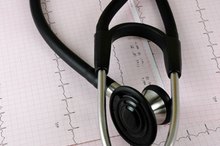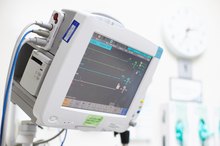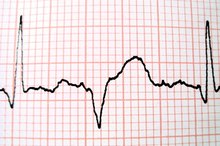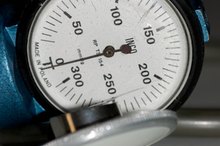What does fact checked mean?
At Healthfully, we strive to deliver objective content that is accurate and up-to-date. Our team periodically reviews articles in order to ensure content quality. The sources cited below consist of evidence from peer-reviewed journals, prominent medical organizations, academic associations, and government data.
- National Heart, Lung, and Blood Institute: Electrocardiogram
- National Heart, Lung, and Blood Institute: Electrocardiogram
- Medline Plus: Heart Disease
The information contained on this site is for informational purposes only, and should not be used as a substitute for the advice of a professional health care provider. Please check with the appropriate physician regarding health questions and concerns. Although we strive to deliver accurate and up-to-date information, no guarantee to that effect is made.
How to Count the Boxes on the EKG Paper to Determine Rate
Heart disease is the number one killer in the United States according to The National Institute of Health Medline Plus website 3. The electrocardiogram is a valuable tool in combating and identifying elements of heart disease 23. An electrocardiogram, also called EKG or ECG, is used to detect and identify problems with heart function 2. The EKG provides information about the electrical activity of the heart and the rate and rhythm at which the heart is beating. Understanding how to interpret boxes on the EKG paper is a valuable skill in heart health care.
Understanding EKG Blocks
Count the number of blocks between the rate that you want to determine. The EKG graph paper is divided into one millimeter size squares. The distance between each square (going from left to right) represents 0.04 seconds. The one millimeter blocks are the smallest subdivisions on the EKG paper. Five of the one-millimeter blocks equal one large block that represents 0.2 (5 x 0.04) seconds. Accordingly, five of the large blocks equal one second of time (5 x 0.2) on the EKG. Determining the heart rate is a matter of counting the blocks between two reference points that you determine and translating the number of blocks to time.
How to Measure Heart Rate on a Telemetry Strip
Learn More
Find the reference points on the EKG paper that correspond to the heart rate that you want to measure. The p-waves indicate contraction of the upper chamber of the heart (atria) and the r-waves indicate contraction of the lower chamber (ventricles) of the heart. Count the number or p-waves in one minute to determine electrical rate of the atria contracting.
Count the number of r-waves in one minute to determine the electrical rate of the ventricles contracting.
Determine the number of boxes in one minute. Fifteen large boxes equals three seconds. The EKG graph paper has markings between each segment of 15 large boxes to indicate the 3 second intervals. Attain a 6 second EKG strip (30 large boxes) and multiply the number of p-waves in the six second strip by 10 to determine the number of atrial beats in one minute.
To determine the number of ventricular contraction multiply the number of r-waves in the 6 second EKG strip by 10.
- Count the number of blocks between the rate that you want to determine.
- Attain a 6 second EKG strip (30 large boxes) and multiply the number of p-waves in the six second strip by 10 to determine the number of atrial beats in one minute.
Alternate Methods
How to Read an Abnormal EKG
Learn More
Determine the atrial heart rate by counting the number of one millimeter boxes between two consecutive p-waves then divide the number by 1,500. To determine the ventricular heart rate, count the number of one millimeter boxes between two consecutive r-waves then divide the number by 1,500. This method may be used only if the heart rate is regular--the distance between consecutive r-waves or p-waves is equal. The number 1,500 is used because 1,500 millimeter boxes are equivalent to one minute.
Use the heavy boldfaced lines that indicate 3 second increments to count the number of p or r-waves in one minute. Memorize the following sequence of numbers as stated in the ECG Strip Ease Book, "300, 150, 100, 75, 60,50. 4"
Start with the p-wave or r-wave (according to which rate you are measuring) closest to a heavy line on the EKG paper. Assign the next series of heavy lines the six numbers respectively. The p-wave rate (atria) is determined by recording the number value of next p-wave that is closest to a heavy line. The r-wave rate (ventricular) is determined in the same manner using the r-wave closest to heavy lines.
Tips
Measure the pulse by counting pulsations in a vein or artery to determine whether electrical activity of the heart is resulting in contraction of the heart and blood flow. The EKG pattern records electrical activity of the heart, not blood flow or actual muscular contraction.
Warnings
The ECG Strip Ease book warns "always check a pulse to correlate with heart rate on an ECG."
- Determine the atrial heart rate by counting the number of one millimeter boxes between two consecutive p-waves then divide the number by 1,500.
- The r-wave rate (ventricular) is determined in the same manner using the r-wave closest to heavy lines.
Related Articles
References
Tips
- Measure the pulse by counting pulsations in a vein or artery to determine whether electrical activity of the heart is resulting in contraction of the heart and blood flow. The EKG pattern records electrical activity of the heart, not blood flow or actual muscular contraction.
Warnings
- The ECG Strip Ease book warns "always check a pulse to correlate with heart rate on an ECG."
Writer Bio
Miriam Breeze, a freelance writer since 2009, is a 12-year Marine Corps veteran and was a merchant mariner for five years. She specializes in health care topics and has published articles on eHow.com and Answerbag.com. She has a Bachelor of Science in nursing from National University and a California registered nursing license.









